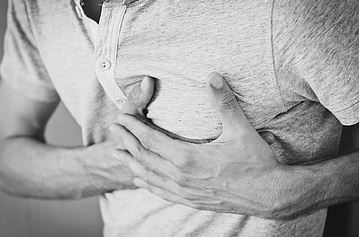We wait all year for the time when we can spend our days outdoors and enjoy the weather and the beautiful flowers, but for some, the great outdoors can lead to some things that are not so great. For those who suffer from respiratory difficulties, you could find that breathing becomes more difficult when out getting some fresh air. Getting a better understanding of your breathing problems, along with an accurate medical diagnosis will allow you to get effective treatment and regain control. Daily control is vital to helping you live an active and productive life.
Causes of Breathlessness
There can be many reasons for experiencing breathing problems. For some, it may be just the common cold, for others, it may be an acute bout of acute sinusitis. For others, breathing problems are chronic or long-term. Here are a few reasons you may experience increased difficulty breathing and what you can do about it.
Allergies
More than 50 million American have hay fever or allergies. Some of the most common culprits of allergy attacks include pollen and mold. These and other allergens do more than cause itchy eyes, a runny nose and nasal congestion. They can also irritate the airways in your lungs. This can trigger an asthma attack and make it hard for you to take normal breaths.
Signs: Coughing, wheezing, chest tightness. Symptoms may last a few minutes to several days.
What helps? An inhaler can reduce swelling in your airways right away. Long-term medicines will stop you from reacting as much to your allergy triggers.
Asthma
The number one trigger for asthma is allergies, which often occur together. Almost 17 million people suffer from asthma. A nasal or sinus passage inflammation may trigger reflexes and cause asthma attacks. Symptoms last from a few minutes to several days.
Signs: Nasal congestion, wheezing, itchy or watery eyes, runny nose, labored or shallow breathing and chest tightness.
What helps? Sit upright, stay calm, move away from the trigger, drink a hot caffeinated beverage and use prescribed medication, if available.
Infection
Springtime can lead to increase in sinus infections and other traveling germs. If germs come into your body through your nose and mouth, they can travel to your lungs and cause an infection, and may even turn into pneumonia. Anyone can get an infection, but you’re at higher risk if you have a weakened immune system, a lung disease like asthma or you smoke.
Signs: Nausea, fever, chills, diarrhea, vomiting, chest pain. You may also have thick mucus when you cough.
What helps? Antibiotics usually do the trick, but some people need to be hospitalized for treatments to help their lungs heal completely.
Chronic Obstructive Pulmonary Disease (COPD)
Permanent lung damage that gets worse over time. Two most prevalent forms of COPD are emphysema and chronic bronchitis. Symptoms include feeling like you can’t catch your breath or that you feel like you are suffocating.
Signs: dyspnea (shortness of breath), larger amounts of yellow or green sputum, wheezing, sore throat, coughing, and/or fever. Other manifestations can include fatigue, acute confusion, malaise, or worsening exercise tolerance.
What helps? Treatment is typically with a course of antibiotics and/or oral corticosteroids, although frailer patients may require hospital admission depending on the severity of the COPD or if they are experiencing acute respiratory distress.
Although many of these conditions require medications for the more severe cases in order to improve breathing, there are some tips that you can follow to minimize your risk for having acute exacerbations and the need for hospitalization. Being mindful of some of your daily tasks can make a huge difference in keeping you breathing deeply and enjoying the season.
General Tips for Managing Exacerbations
 Pay attention to the great outdoors. Every Single Day. If you are someone who likes to be physically active outdoors, then it’s important to remember to check for obvious triggers. The air quality that we breathe can be troublesome for those with allergies, asthma and COPD. Check daily for air quality levels and pollution forecasts in your area to ensure that you are safe for frolicking in the grass.
Pay attention to the great outdoors. Every Single Day. If you are someone who likes to be physically active outdoors, then it’s important to remember to check for obvious triggers. The air quality that we breathe can be troublesome for those with allergies, asthma and COPD. Check daily for air quality levels and pollution forecasts in your area to ensure that you are safe for frolicking in the grass.
Consider a mask during yard work and garden maintenance. Before working out in the yard, make note of the local pollen count in your area. Fertilizers and freshly cut grass can trigger allergy symptoms from breathing in tiny particles. Consider going out in the early morning or evening when the pollen count is at its lowest.
Don’t forget to take your medications. Always be sure to use your preventative or controller medications as prescribed, even if you feel like you don’t need them. Limiting your exposure to triggers will help, but it doesn’t eliminate all the risks. If you are prone to a flare up, keep your quick-relief medication close. Just as a side note, you may try taking your allergy medication late at night so that when you wake up your medication will be in full defense, when allergies tend to be at their peak.
Be Cautious of Spring Cleaning. Some of the cleaning products we use to make our house spic and span contain harsh odors and are extremely potent and can be bad for breathing problems. If you are using chemicals that clean the oven, wall, floors and toilets, you may consider the option of hiring some professional help or recruiting your fiends and family to keep you far removed from the fumes. If you suffer form COPD, then this is especially true.
Stay away from the bug spray. Using bug spray or citronella candles may hep keep the bugs at bay, but it could also trigger an asthma episode or make breathing more challenging. Try to stay several feet away from strong smelling candles and use unscented lotions or repellants instead of aerosol sprays. If you want to avoid the repellent products all together, then covering up with a long sleeved shirt, long pants and socks can prevent bug bites. It is also a good idea to stay away from stagnant water, and stay indoors at sunrise and sunset when mosquitos are most active.
Bundle up. Although spring is the time when the weather starts to warm up, there can still be chilly days that arise here and there. Be sure to check the weather report and dress accordingly before heading outside. It a good idea to bring along an umbrella and a light jacket along in case the weather changes for the worse.
Start back slowly. If it’s been a while since you have exercised, then ease yourself back into it. Don’t push yourself to the point of being fatigued. When you go out and about, always carry your cell phone in case you become tired and are not near your home. It may be necessary to call yourself a ride or worse, call for medical assistance.
With the help of these tips and talking to your doctor, you can help to manage your breathing and keep your lungs happy. Pay attention to your triggers and be sure to take your medications regularly so that you wot miss out on enjoying the fresh air and sunshine during the most beautiful time of year!

